The western civilization can be traced from the Celtic reign. The Celts though believed not to have been the inhabitants of Europe nevertheless reigned in Europe before the Romans took. The reign of the Romans introduced road systems and cities after their departure the Anglo-Saxons took over.
The Celtic Reign
- Archeological digs in Eastern Europe and Asia Minor indicate the possibility that the Celts were not native to Europe.
- Originally Celts were a dark haired people with swarthy complexions.
- Thought to have migrated through Europe to what is now England.
The Celts have been reported to have been diverse. Their empire has been reported to have spanned the European continent. Archaeological evidence from Germany and Scotland has proved that there was Celtic settlement as early as the late Bronze Age.
Archaeological evidence collected from Asia Minor and Eastern part of Europe do not show that the Celts were Indigenous to Europe. It is reported that they were dark haired with swarthy complexions.
The Celts are believed to have migrated to Europe through the Asia Minor. Soon after settling in the Danube River basin they are said to have began conquering their neighbours a practice which continued to cover wide geographical region. The Celts covered most of the Western Europe region. The Celtic dominance was short lived as new conquerors narrowed down the influence of the Celtic people.
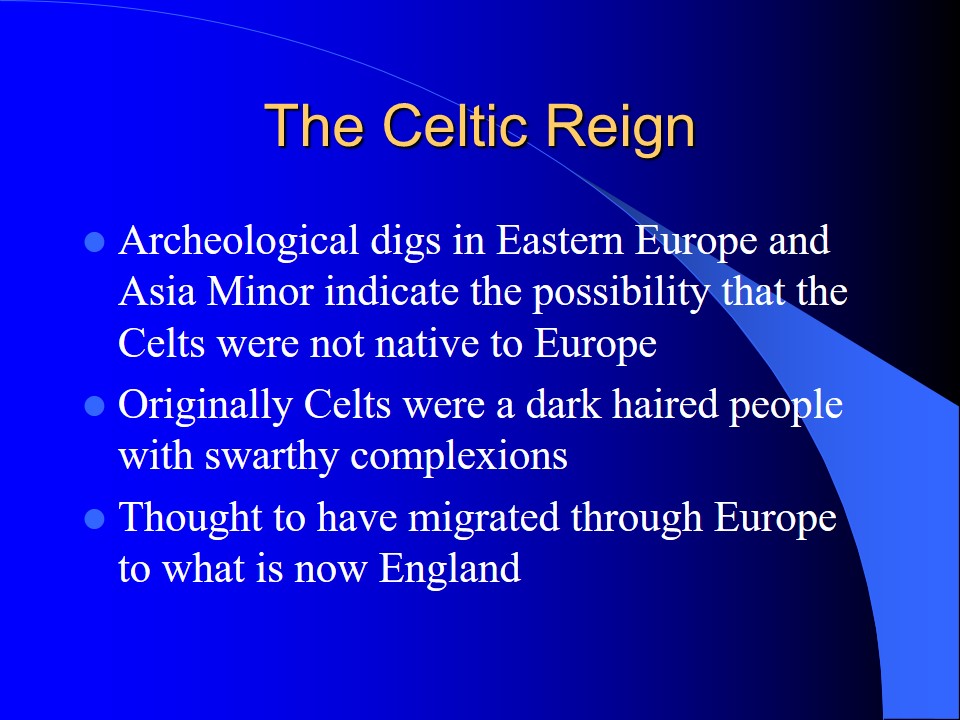
The Celtic Civilization
- Celtic tribes divided into family clans.
- Celtic society divided into 3 classes: a warrior aristocracy, an intellectual/religious class, and the common people.
- The Celts were civilized probably even before the Romans and Greek.
- Cattle was an important food source.
- First Europeans to make iron.
- Art consisted of curves and spirals often called Celtic knots.
- Had a pagan religion worshipping many gods; threw jewelry and weapons into streams and lakes as offering to the gods.
- Stonehenge- located in southern England; possibly built by the Druids which were the high priests of the Celts; ancient megalith that was constructed beginning about 3000BC and stopped around 2000BC; blue stones for building brought in from Wales; may have been a lunar calendar, a temple, or a burial ground.
- France and Ireland had monuments similar to Stonehenge.
- Celtic women had rights and generally treated with respect.
Little is known about the culture of the Celtic people. It has been said that they were nomadic. Though the Romans identified them with the barbaric tribes, it has been revealed that they were high organized. The Celtic society consisted of three classes: a warrior aristocracy, an intellectual/royal class, and the common people. The common people were considered free men.
Though the Romans and Greeks are said to have viewed the Celts as the savage race, archaeological evidence has proved otherwise. It has been reported that the Celts used chain mail in battle and had machines for reaping grain. It was reported that long before the Roman road system was in place the Celts had started some form of roadways across Europe. The use of soap is also highly believed to have been invented by the Celts.
To the Celtic cattle was an important source of source of food. They are considered the first Europeans to have made iron considering the fact that they had machines which were used to harvest grain. The Celtic people preferred simple rural life as opposed to urbanized life. The clothing have been claimed to have followed a plaid design. Celtic knots consisted of curves and spirals. They are said to have worshiped pagan gods. Some of the practices in which they got engaged in included throwing offering jewels and weapons to their gods by throwing them in rivers.
Unlike the depiction of the Celtic people by the Romans, the Celtic people were highly educated. They Celtic priests and scholars who were referred to as Druids were required to undergo lifelong studies which could last as much as 20 years of training.
The Stonehenge which are located in Southern England are believed to have been constructed by Druids. They are said to have been constructed between 3000 BC and 2000 BC. The bluestone for building the Stonehenge are said to have been brought in from Wales. The exact purpose for the construction of the Stonehenge is not known but due to the huge amount of labour which was required to construct them it is generally assumed that the Stonehenge served a special purpose in the Celtic society.
It has been observed that there are monuments in France and Ireland which are quite similar to the Stonehenge in Southern England. This might be an indication that the Celtic people inhabited France. It has been claimed that the Celtic women were treated with respect.
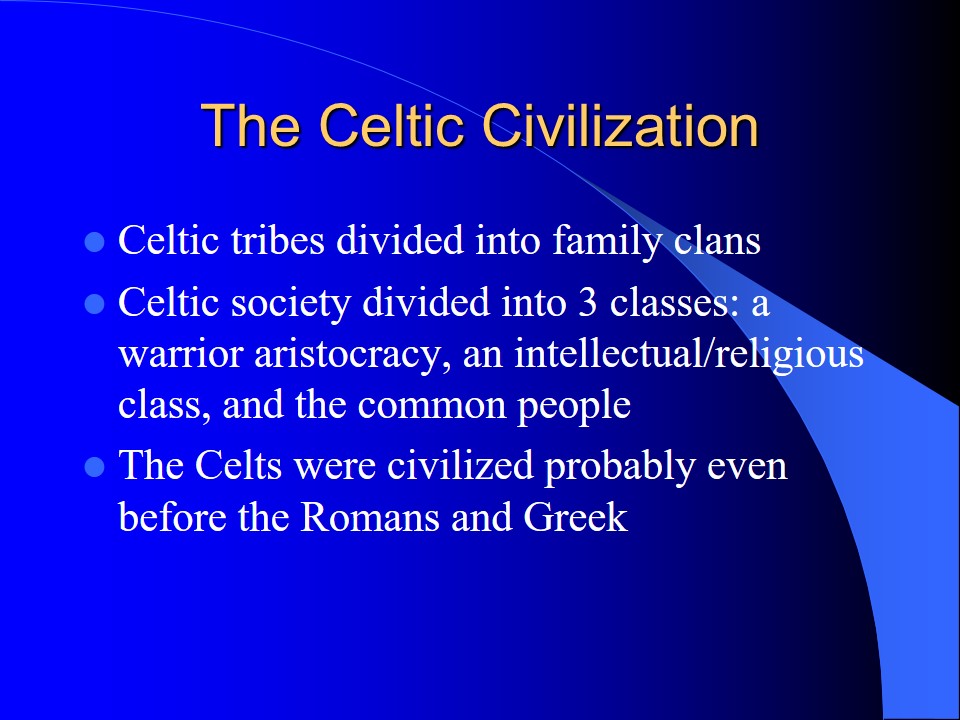
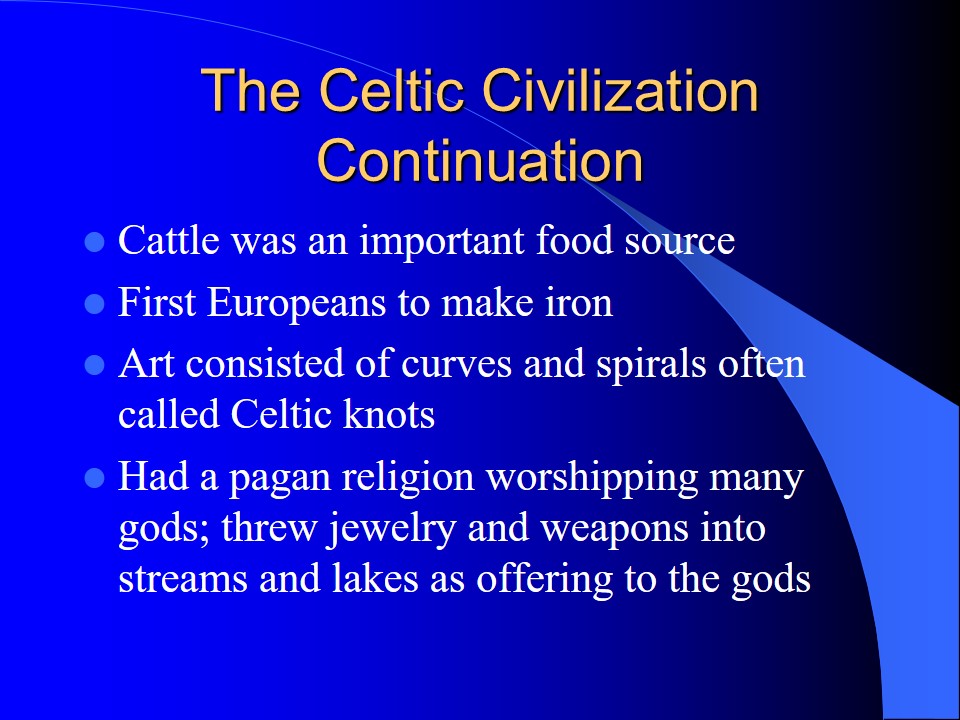
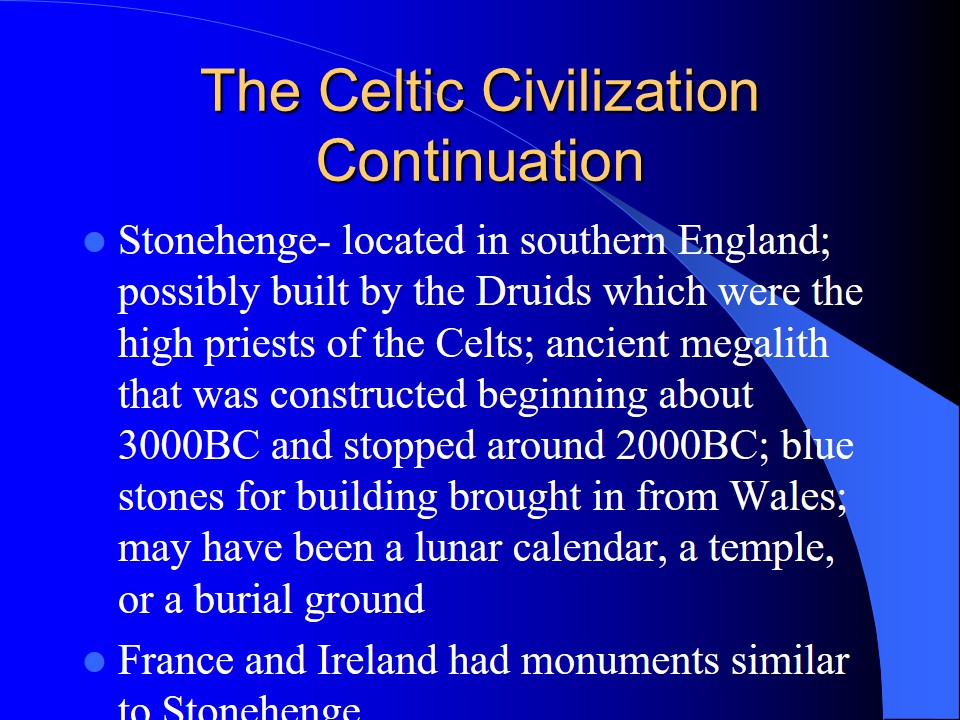
Roman Province Britannia
- 55BC- invasion of British Isles under Julius Caesar.
- 43AD- Emperor Claudius established in Kent, but could not settle the highlands and moorlands (now Scotland) due to harsh terrain.
- Roman society in Britannia had many classes.
- Roman achievements included system of roads.
- Revolt of Magnus Maximus in 383AD began the disintegration of Roman Britain.
The first Roman invaded the natives of the British Isles in 55B.C. under the guidance of Julius Caesar. The invasion was not a significant as such and was followed later by a major invasion in 43A.D. ordered by Emperor Claudius. Due to what has been reported to be a mixture of lack of cooperation among the Celtic tribes and general luck on the part of the Romans, Britain was subdued in less than forty than forty years. This gave birth to the Roman province called Britannia.
It was not possible for the Romans to settle in the highlands and moorlands as they were said to be poor agriculturally and that the terrain was too harsh for settlement. Some of the achievements that the Romans made in the Roman Province of Britannia included vast networks of road systems, and development of cities. The Roman settlement in the Britannia introduced many classes in the society. It is said that the Roman province of Britannia remained intact up to around 383 AD during the revolt of Magnus Maximus. This marked the departure of the Romans from Britain.
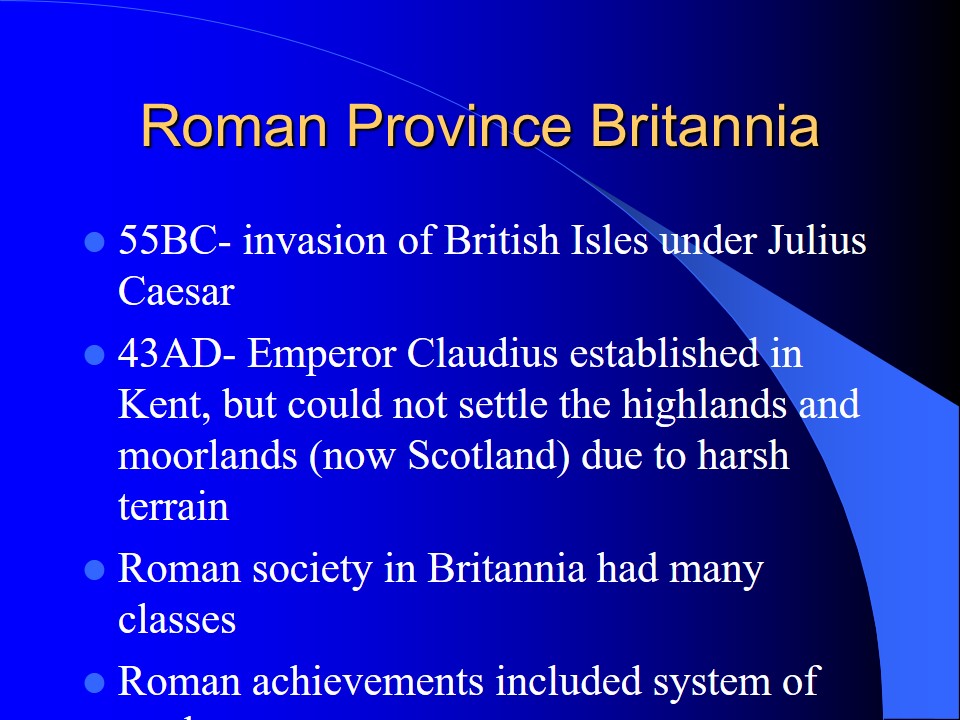
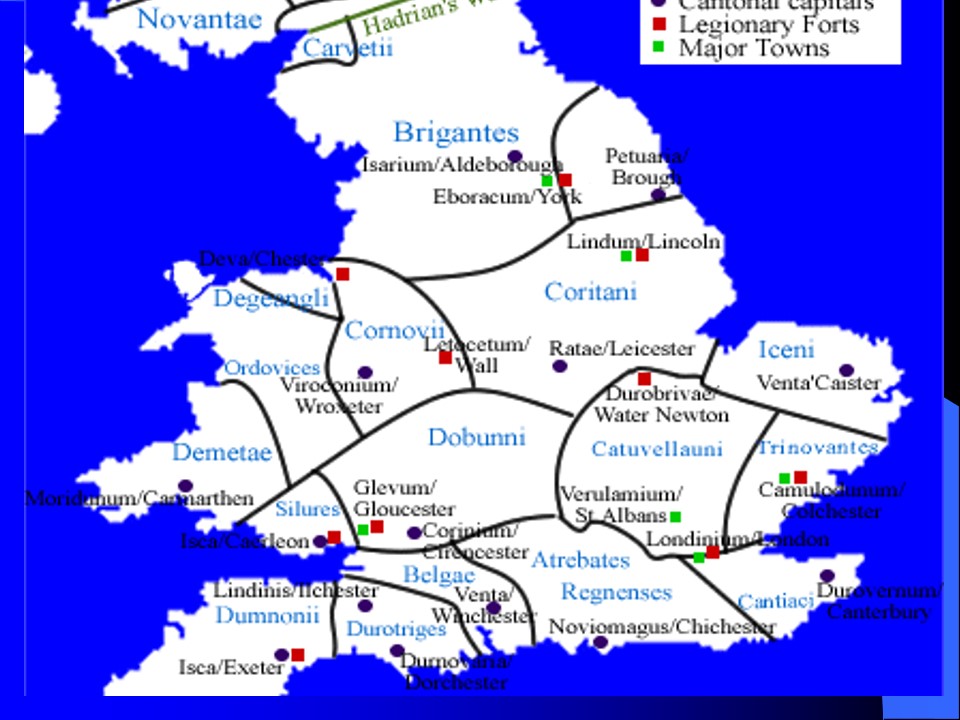
Saxons Departure of the Romans and arrival of the Saxons
- Early in the fifth century, Roman armies withdrawn by Constantine III from Britannia to defend their empire.
- Were from the northern German region of Saxony on the south Jutland Peninsula who settled in England around 410AD.
The arrival of the Saxons was ushered by the departure of the Roman armies from Britain. The Roman armies departed from Britain at the beginning of the fifth century. Constantine III withdrew the roman armies from Britain for the purpose of the defending the Roman Empire back at home as it was facing some difficulties. Britain was viewed to be too far and had little in the Roman Empire and therefore expensed the empire.
Anglo-Saxon has been referred to be a relatively recent term. The Anglo-Saxons are believed to have come the regions of Saxony and Angeln in Germany. They are said to have come to Britain after the Romans went away at around AD 410.
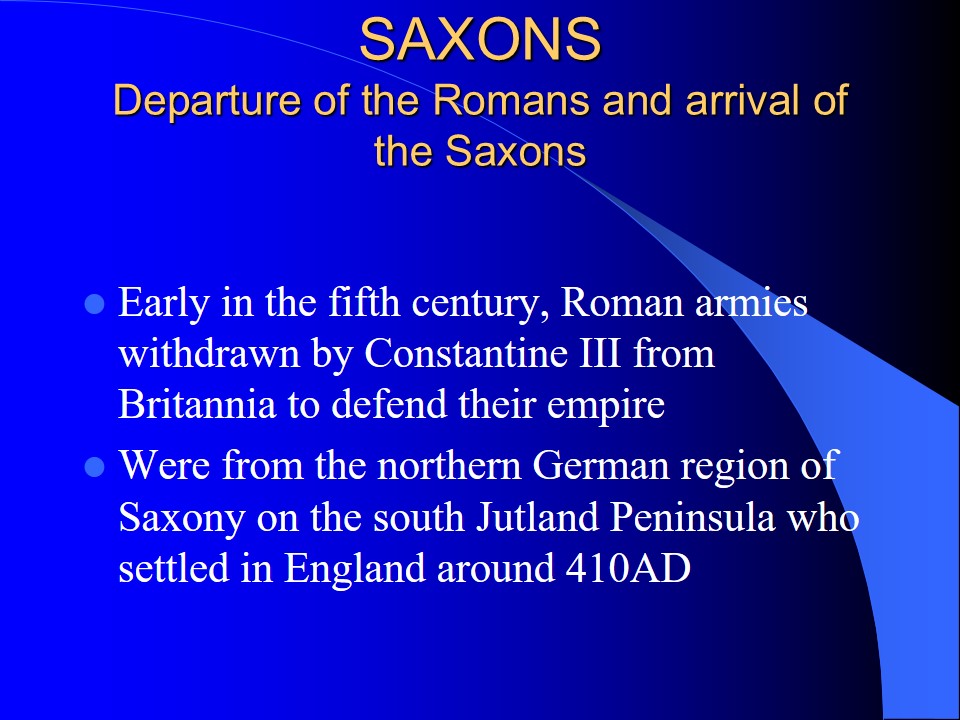
The reign of the Anglo-Saxons
- Eventually controlled eastern and southern England.
- Were farmers and fierce warriors.
- Lived on farms and in villages.
- Used spears, swords, shields, torches and battering rams in war.
- Spoke “Old English”.
- Initially believed in Norse gods like Odin, Frig, Tin, and Thor. Converted to Christianity which spread through most of England.
- Political changes: small tribal groups consisting of kingdoms and sub-kingdoms; eventually divided into 4 kingdoms- Northumbria, Mercia, Kent, and Wessex.
- Jewelry consisted of bronze and silver brooches inlaid with garnet and interlaced with gold filigree.
- Age of power, wealth, culture, government, religion, literature, and art.
It is said that the Anglo-Saxons were masters and though they found the Jutes and Frisians in the British Isles they soon overcome them. It is said that the Anglo-Saxons replaced the Roman structures with their own. For instance it is reported that the stone building built by the Romans were quickly replaced by wood buildings built by the Anglo-Saxons. In this manner the Roman legacy was easily killed.
The influence of the Anglo-Saxons spread wide and they ended up controlling eastern and southern England. They were said to be fierce warriors who lived on farms and in villages. They are also said to have used swords, spears, shields, torches and battering rams in war.
The Anglo-Saxons are said to have spoken their own language that gave rise to the modern English spoken today. They are also reported to have brought their own religious beliefs with gods like Odin, Frig, Tin, and Thor. The arrival of Saint Augustine led to the conversion of the country to Christianity. The Anglo-Saxons are said to have reigned for almost 600 starting from 410 to 1066. During the reign of the Anglo-Saxons there were changes which took place on the land.
During the reign of the Anglo-Saxons the country is said to have been divided into four kingdoms: Wessex, Northumbria, East Anglia and Mercia. The four kingdoms are said to have come up from the early settlers who had kept to small tribal groups forming small kingdoms and sub-kingdoms. The jewellery consisted of bronze and silver brooches inlaid with garnet and interlaced with gold filigree.
The Anglo-Saxons reign is considered as an age of power and wealth. It is during this age that religion was introduced, government structure was introduced and literature and art took control. The Anglo-Saxons came to an end in 1066 after the death of Edward who did not have an heir. The Normans took the reign after defeating Harold who had just been crowned as the King.
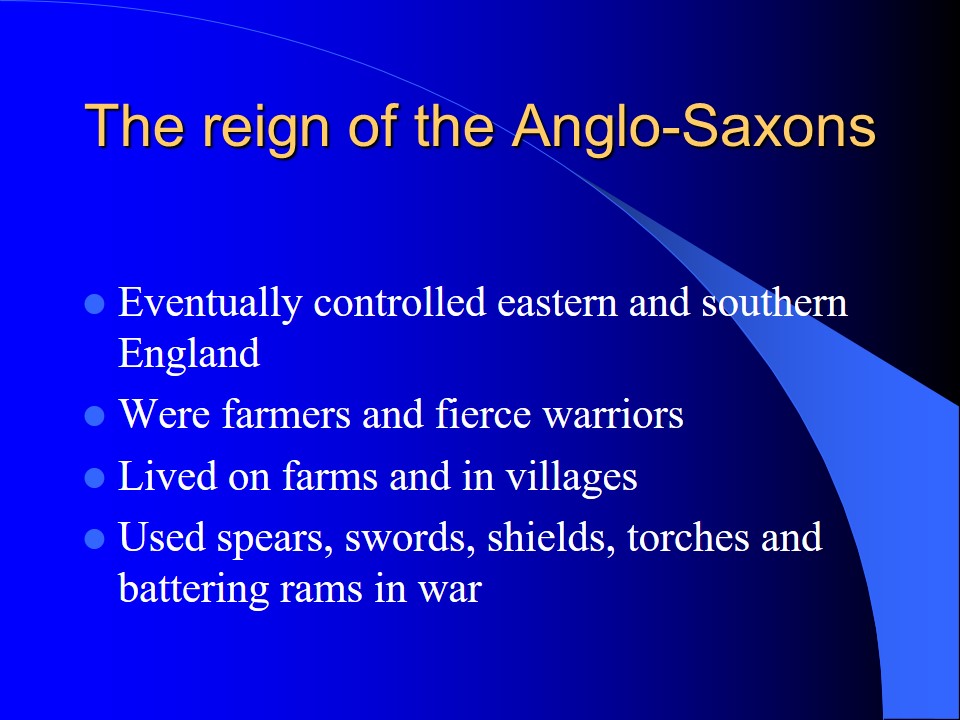
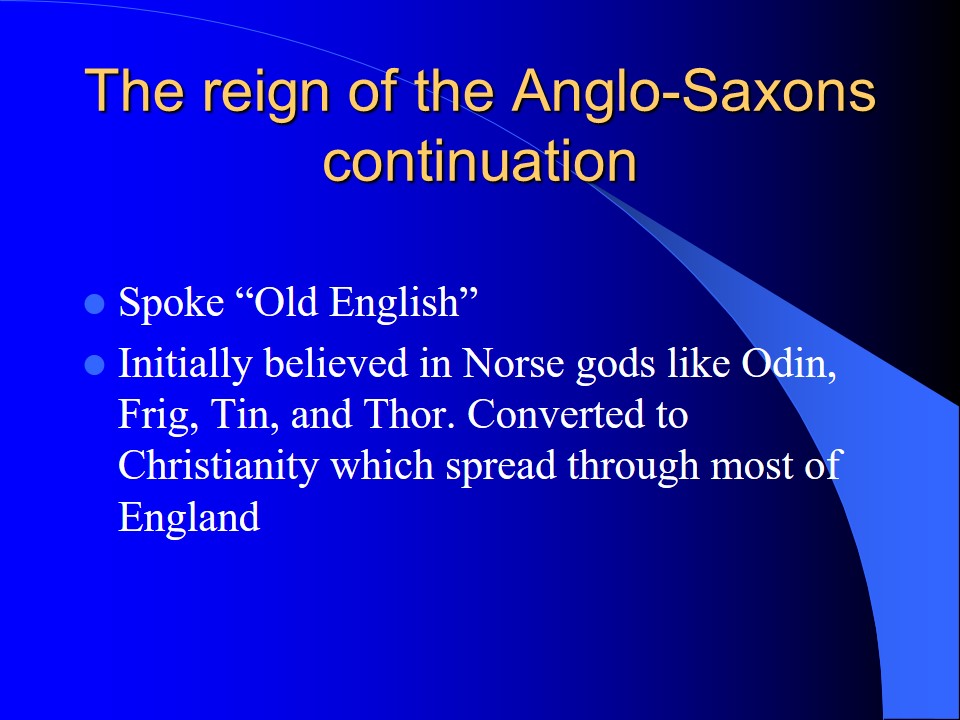
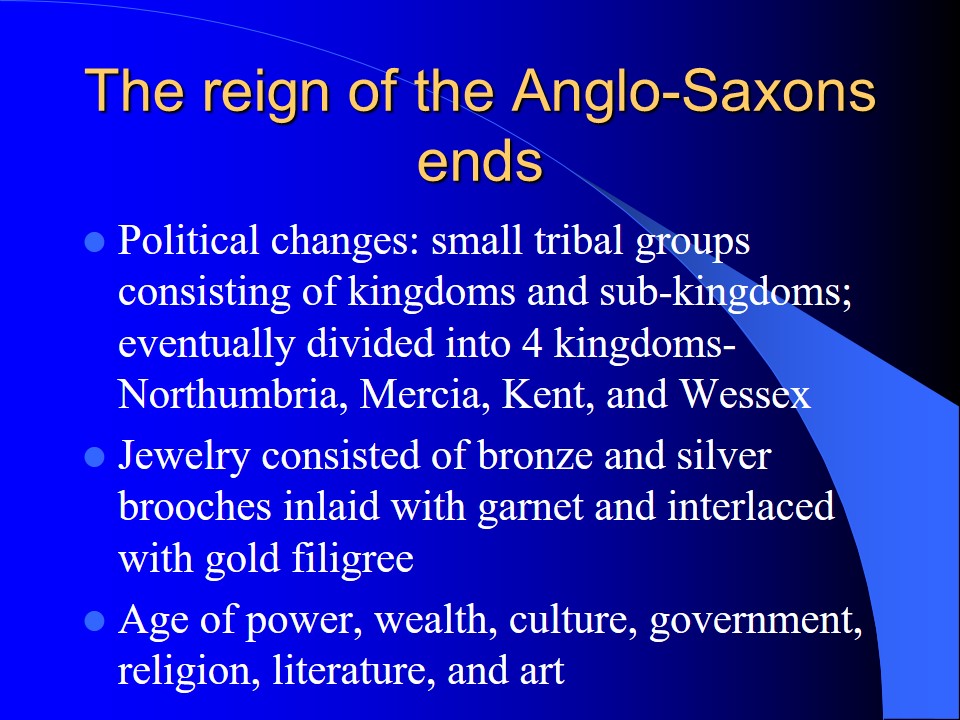
Reformation
- The Black Death (bubonic plague)- 1328-1351; killed 30 to 40% of the population in England ; went from farming to pasturing; boost in the cloth and wool industries; people moved into towns; decline of the Feudal system; disillusionment with the church; helped spur the English reformation.
- 14th to 16th centuries considered a period of “rebirth”; Francesco Petrarch is considered the father of the Renaissance.
- Changes in religious thought brought about by a move away from the Catholic Church; change influenced by Martin Luther, a German Augustinian monk; changed the idea of purgatory.
The reformation was a movement that had began as way to reform the Roman Catholic Church. The reformation was as a result of the church followers not being generally satisfied with the church. Some of the complains forwarded against the church included extreme focus on rituals, false doctrines and sell of indulgences. The selling of indulgences is especially said to have created a lot wealth for the Catholic Church. There are many factors which are said to have brought about the reformation. Some events which had taken place early and the general trend of the behaviour of the Roman Catholic Church must have disillusioned the people.
The Black Death which occurred between 1328 and 1351 was one such event which is said to have disillusioned people and set it against the church. This plague claimed good portion of the population which has been estimated to be around 30 to 40% of the then England population. Due to the reduction in the population there was a general movement of the population from the villages to towns. There was also a decline in the Feudal system and the general population was disillusioned with the church in general. This set the stage for the reformation.
The 14th to 15th century has considered a rebirth period. This is a period when so many things changed. One Francesco Petrarch has been viewed as the father of the Renaissance. There were changes in the way people viewed religion and this brought about a movement away from the church. People like Martin Luther significantly contributed in the changing attitude of the people against some of the church doctrines such as purgatory. Martin Luther is said to have published a thesis in 1517 which sharply criticised the ritual of selling indulgency and the policy of purgatory. Luther also criticised the church for not allowing the translation of the bible into other languages which other people could understand. Apart from Martin Luther there were other theologians who also speared the reformation all over Europe. The English reformation is said to have been very clear when England broke away from the Roman Catholic Church authority through the actions of King Edward divorcing.
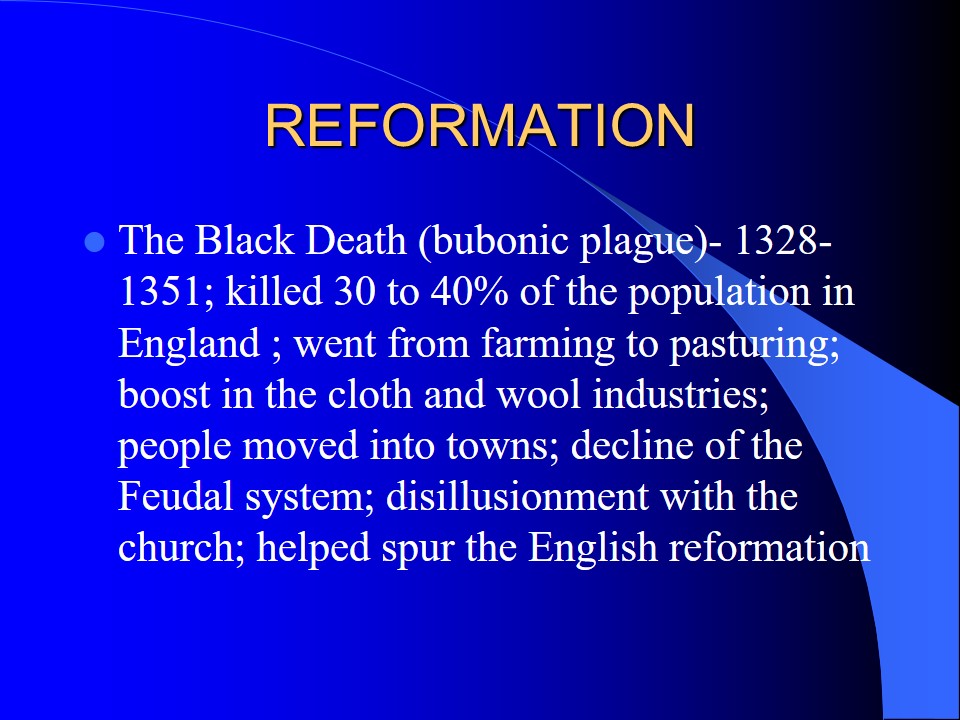
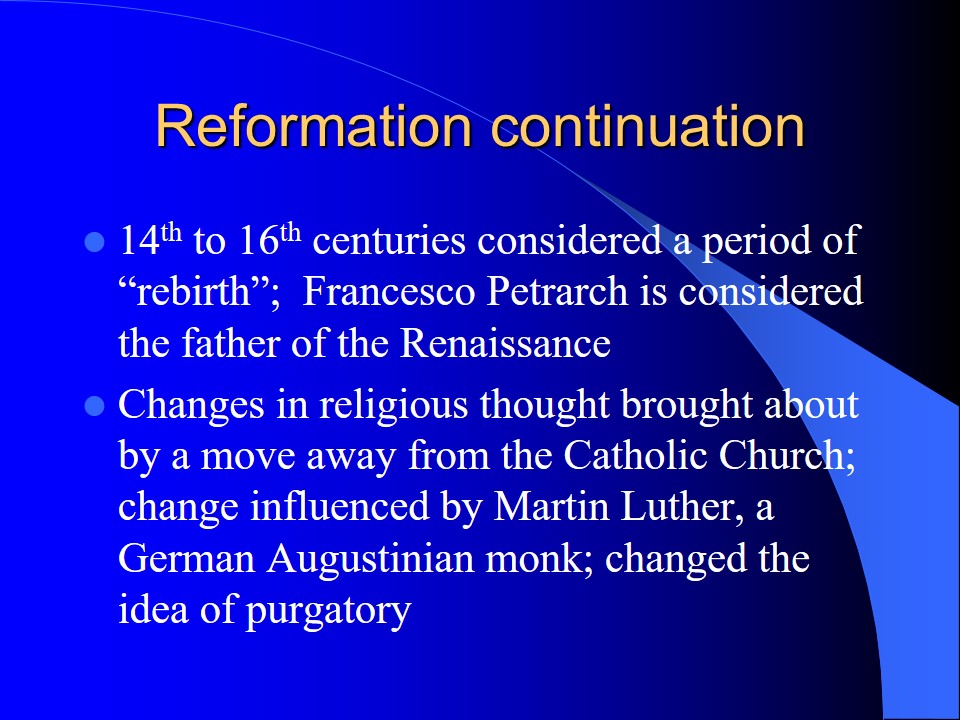
The English Reformation
- King Henry VIII sought a divorce and was excommunicated from the church by the pope giving the official start to the period of reformation.
- Most monasteries shut down by 1540.
- Improvements in agricultural techniques saw the rise of a wider variety of food.
- With the movement into towns there were a wider variety of jobs such as blacksmith, carpenter, baker, scribe, and shoemaker.
- Changes in science and technology.
- Plays and theatre such as Shakespeare.
- Increase in trade.
- Women considered inferior and girls were not allowed to attend universities.
The English reformation took place when King Henry VIII divorced against the Church. The breaking away of the England from the church has been considered more of a political break away than a religious break away. This is considered so because the breakaway was necessitated by personal affairs of the King’s need for a heir whom the queen Catherine had failed to give. The king wanted to marry another woman but first had to divorce his wife. The church did not allow divorce and though the king tried to plead with the pope to allow him a divorce on the special dispensation it was not possible. This made the King to go ahead against the pope and divorce his wife in order to marry again. Following the divorce by the King he was excommunicated by the pope marking the official date of the English reformation.
It should be noted that the church had gathered a lot of wealth from selling indulgence. It is reported that literary to do anything which involved the church one had pay, for instance, baptism was paid for, burials services were paid for and any other service which involved the church was also paid. This is said to have made the church monasteries to be very rich. The excommunication of England from the Roman Church led to the church properties being taken by the government.
During the English reformation there many improvements made. The agricultural sector experienced a lot of improvements technologically. There were new agricultural techniques which made resulted to quick growth in the amount of agricultural produce. It is also reported that there was an increase in the amount number of jobs available which ranged from carpentry, baking shoemaking, blacksmith among others.
There were advances witnessed in the sector of science and technology. Literature developed richly during this era. The volume of trade also increased significantly. The education system advanced greatly though girls were not allowed to attend institutions of higher learning. Women wee generally viewed as inferior in the society.
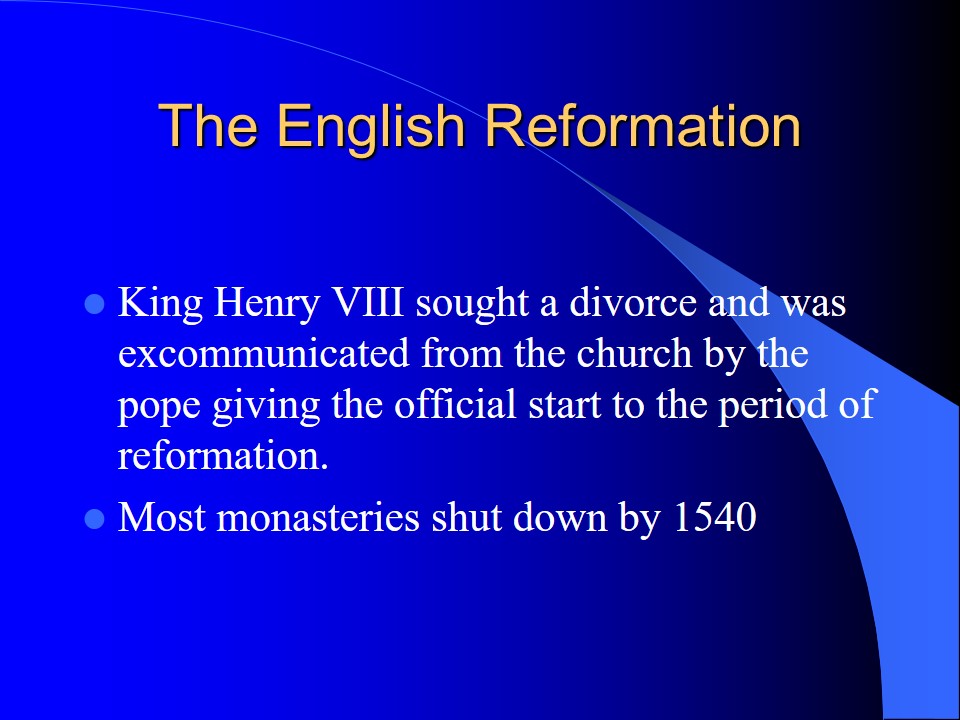
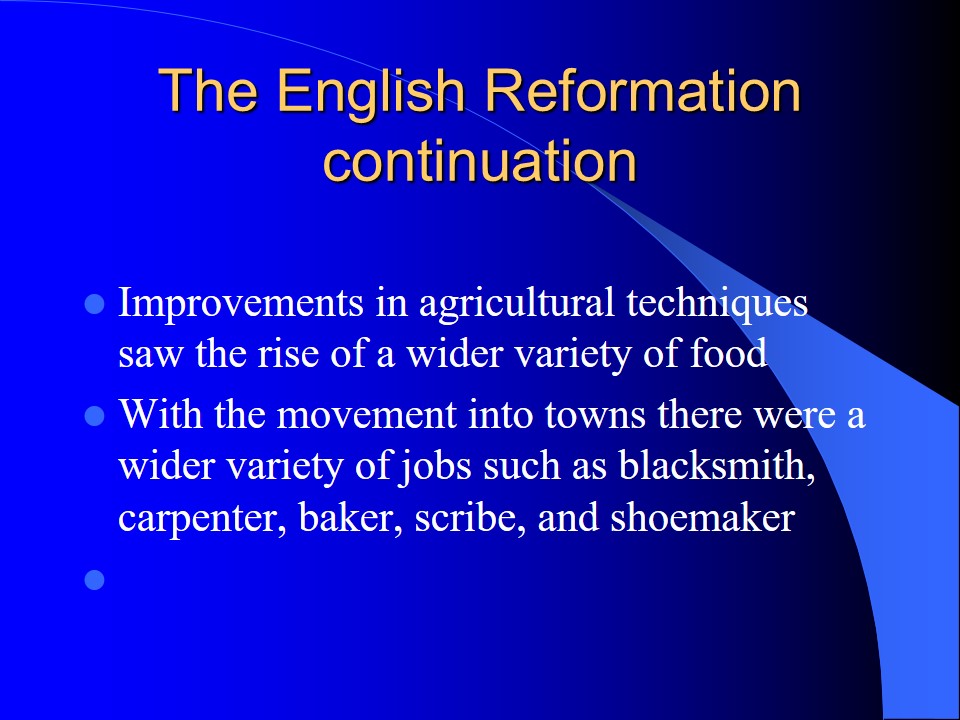
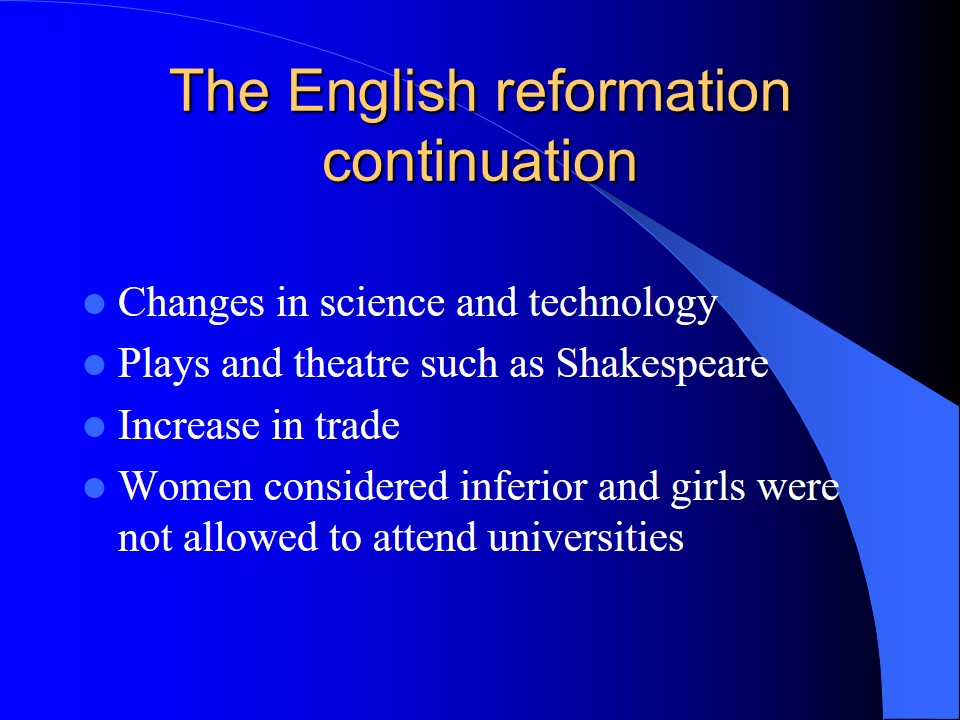
Works Cited
Chris, Trueman. The Black Death of 1348 to 1350. History learning Site, 2000-2010. Web.
Griffin, KD. Interesting Facts about the Protestant Reformation. Associated Content, 2007. Web.
Mitchell, Esther. Ancient Celtic History. Essortment, 2002. Web.
Saxon, MC. A Brief History of the Anglo-Saxons, 2010. Web.
Sightlines. Stonehenge. Britannia, 2007. Web.
Trueman, Chris. The Reformation. History Learning Site, 2000-2010. Web.
Williams, Peter. Narrative History of the Saxons. Britannia History, 2007. Web.